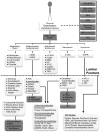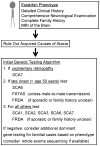Clinical neurogenetics: autosomal dominant spinocerebellar ataxia
- PMID: 24176420
- PMCID: PMC3818725
- DOI: 10.1016/j.ncl.2013.04.006
Clinical neurogenetics: autosomal dominant spinocerebellar ataxia
Abstract
The autosomal dominant spinocerebellar ataxias are a diverse and clinically heterogeneous group of disorders characterized by degeneration and dysfunction of the cerebellum and its associated pathways. Clinical and diagnostic evaluation can be challenging because of phenotypic overlap among causes, and a stratified and systematic approach is essential. Recent advances include the identification of additional genes causing dominant genetic ataxia, a better understanding of cellular pathogenesis in several disorders, the generation of new disease models that may stimulate development of new therapies, and the use of new DNA sequencing technologies, including whole-exome sequencing, to improve diagnosis.
Keywords: Ataxia; Autosomal dominant; Cerebellum; SCA; Spinocerebellar.
Copyright © 2013 Elsevier Inc. All rights reserved.
Figures



References
-
- Durr A. Autosomal dominant cerebellar ataxias: polyglutamine expansions and beyond. Lancet Neurol. 2010;9(9):885–94. - PubMed
-
- Klockgether T, et al. The natural history of degenerative ataxia: a retrospective study in 466 patients. Brain. 1998;121(Pt 4):589–600. - PubMed
-
- Fogel BL, Perlman S. An approach to the patient with late-onset cerebellar ataxia. Nat Clin Pract Neurol. 2006;2(11):629–35. quiz 1 p following 635. - PubMed
-
- Fogel BL, Perlman S. Cerebellar disorders: Balancing the approach to cerebellar ataxia. In: Gálvez-Jiménez N, Tuite PJ, editors. Uncommon Causes of Movement Disorders. Cambridge ; New York: Cambridge University Press; 2011. pp. 198–216.
Publication types
MeSH terms
Substances
Grants and funding
LinkOut - more resources
Full Text Sources
Other Literature Sources
Medical

